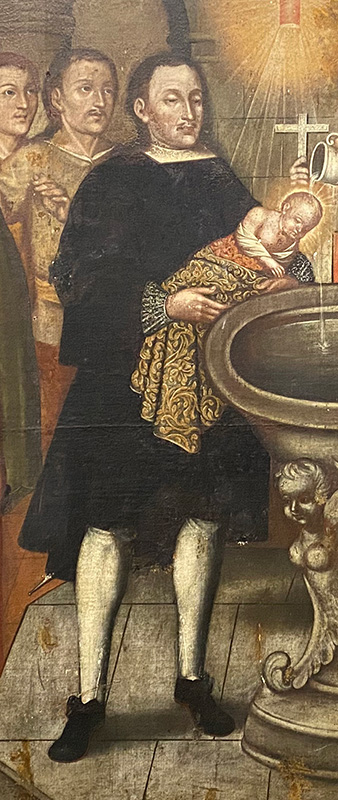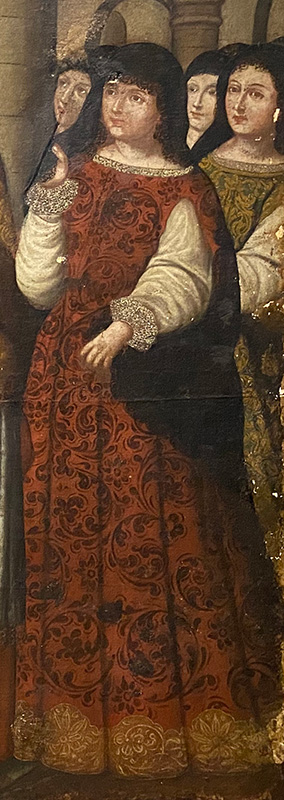Interrogating Fashion Through Religious Painting in Colonial Spanish America
by Laura Beltrán-Rubio
Hiding in the board room of the President’s Office at Universidad de los Andes in Bogotá, Colombia, hangs a c. 1750 scene of the baptism of Saint John, attributed to the famed portrait painter Joaquín Gutiérrez of Nueva Granada (figure 1). The painting has been in this same room for decades—and yet I only saw it for the first time in 2022, when I visited Colombia with the support of a Decorative Arts Trust Research Grant. Having visited this university several times throughout my childhood with my father, attended for five years as an undergraduate student, and taught courses since 2017, this treasure of 18th-century colonial Spanish American art was hiding in plain sight.
In the painting, an infant St. John is being baptized, held above a gray stone baptismal font by a male figure—likely representing his Godfather—clad in a black suit typical of 17th-century Spanish male fashions (figure 2). White accessories complement his outfit: a stiff golilla, fine lace cuffs, and stockings. Behind him stands a group of men dressed in humbler ensembles of cape, doublet, breeches, and stockings of different colors. Baby St. John is richly wrapped in a white linen blanket and a second outer-blanket with golden, possibly embroidered, scrolling motifs on emerald green and red grounds.
On the right side of the baptismal font is a bishop wearing a cope of golden brocade with floral motifs and a golden maniple with scrolling leaves over his white alb. A child acolyte stands in front of him, dressed in the typical red cassock and white surplice pair. Further to the right is a group of women, seemingly uniformed in the same style of dress (figure 3). The woman in front wears a gown made up of a red brocaded fabric with black scrolling motifs and a golden lace border at the hem. The sleeves are vertically slashed to reveal a long-sleeved white shift with fine lace cuffs that match the delicate lace trimming at the neckline. A black lace mantilla frames her face, covering her head and back. A second woman wears a green-and-gold version of the same gown.
The style of dress worn by these women is a particularly interesting choice for a religious painting, especially because it seems to resemble 18th-century fashions more closely than the antique designs featured more often in historical and religious paintings. However, their dress also departs strikingly from what elite European women of the time would have worn for such a special occasion. They wear neither a court gown nor a robe à la française, and the painting is certainly too early for the high-waisted, tubular gowns that became fashionable towards the end of the century. Their attire is, however, much more contemporary than the 17th-century-style outfits worn by the men depicted in the painting.
I studied dresses portrayed in this and other paintings from the Viceroyalty of Nueva Granada as part of my doctoral research, and discovered that the dresses worn by the women in this baptism scene recall those adorning sitters in 18th-century portraits from Quito and Santafé, two of the principal cities of the Viceroyalty. The scarcity of material evidence of historical fashion in the Spanish Americas make it difficult to ascertain whether the clothing depicted in these paintings were representations of actual attire worn by people of the time. However, inquiry into surviving garments and textiles, archival documents, chronicles, and narratives from the 18th century suggest that pictorial depictions of garments in some paintings—especially portraits—mirrored the material world of the sitters.1 For example, an 18th-century waistcoat now at the Museo Colonial in Bogotá offers evidence that the richness of the textiles depicted in portraits were actually worn by some (figure 4). The waistcoat is almost entirely made with metallic threads and, although the accumulated patina has taken away some of its shine, a section under one of the pocket flaps reveals that it once had a silver-colored background with gold-colored flowers that alternate with bundles of tiny blue and brown (perhaps once violet?) flowers.
This time in Colombia provided an invaluable contribution to my understanding of the representation of dress in portraits and paintings of various sorts from colonial Nueva Granada. First, it highlighted the importance of studying portraits of donors alongside stand-alone, secular portraits, especially considering the scarcity of visual references to “real” people in this context. Moreover, it reaffirmed the need for multi-methodological approaches that supplement image analyses with inquiries into the materiality of textiles, discourses about fashion, and even the shared anxieties generated by the so-called “culture of appearances” in the 18th-century Spanish Americas. Finally, it underscored the importance of conducting on-site research and exploring collections in unorthodox places, for it is in unlikely locations where we might find hidden treasure troves.
I take these lessons with me as I finalize my PhD dissertation in the coming months and head into a career in the decorative arts of the Americas. Future research—and my doctoral work more broadly—will continue to interrogate fashion in the colonial Americas as a multifaceted phenomenon drawn from the undeniable presence and influence of Indigenous ways of knowing. As I have continued to inquire into the creation of textiles and garments in Nueva Granada, I have come to realize that the textile primacy of the pre-Spanish Andes survived through the colonial period. Textiles were the protagonist form of artistic production in the region and the Indigenous knowledge, technologies, and appreciation of textiles have continuously shaped Latin American fashion.
- Laura Beltrán-Rubio, “Portraits and Performance: Dress and the Culture of Appearances in the Eighteenth-Century Viceroyalty of New Granada,” The Journal of Dress History 2, no. 4 (Winter 2018): 6–26.
Laura Beltrán-Rubio is a PhD Candidate in American Studies at the College of William and Mary.
A print version of this article was published in The Magazine of the Decorative Arts Trust, one of our most popular member benefits. Join today!




